Chicken karaage is the Japanese version of fried chicken that is insanely delicious- light, crisp, flavorful, and moist. It has a universal flavor that is not too exotic, yet it differs from fried chicken in the US, China, and other countries. It is great as a main dish, an appetizer with drinks, an item in the bento box, and perfect for takeaway sets or picnics.
Karaage chicken was adapted from Chinese cuisine and has assimilated into Japanese culinary culture. Preparation starts with marinating the bite-sized boneless pieces of chicken thigh meat, which are lightly coated with potato starch and deep fried until golden brown.

Note: This post may contain affiliate links. Please read my privacy policy for more info. I may receive commissions for purchases made through links in this post. As an Amazon Associate, I earn from qualifying purchases.
👉 How to prepare the perfect karaage
Karaage is easy to make at home. All the ingredients are easy to find in the markets. It only takes fifteen minutes (excluding marination time) to prepare. Here are the steps:
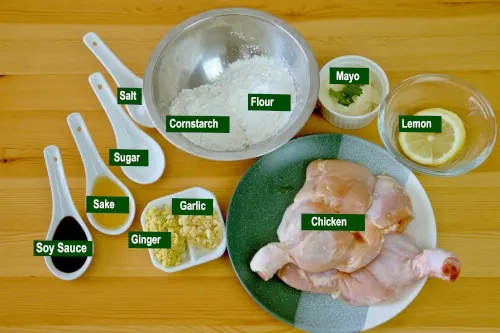
❶ Preparation
- Chop some ginger and garlic finely.
- Add the ginger, garlic, soy sauce, and sake in a bowl.
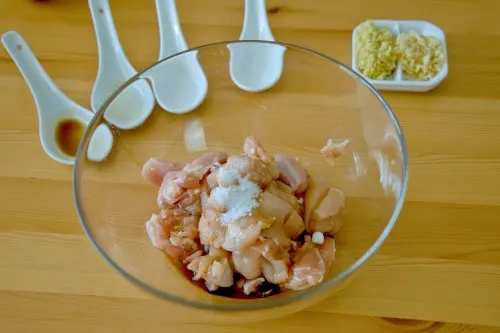
❷ Marinate the chicken
- Score the skinless side of the chicken thighs in a crosshatch pattern. Be careful not to cut through the meat.
- Cut the chicken into 2.5 cm long bite-size pieces, leaving the skin on for extra crispiness. Skin-on chicken thighs are best for making karaage.
- Marinate with ginger, garlic, soy sauce, and sake and refrigerate for at least 30 minutes (better overnight)
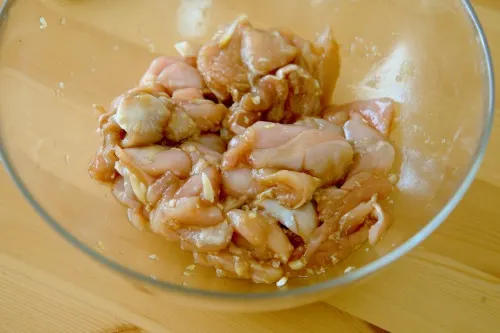
❸ Coat with flour and starch
- Drain off any excess liquid from the chicken. Dredge the chicken meat into the potato starch and wheat flour combination. Dredge each in the flour for the second time to get an even and sufficient coating. Leave them aside, then dip them in the flour once again.
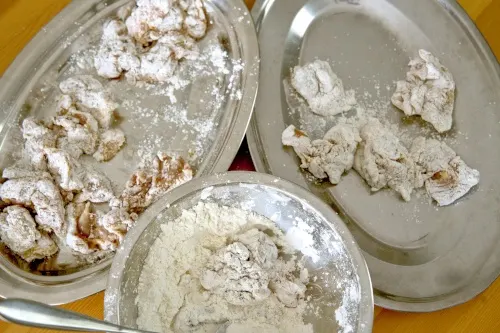
❹ Deep-frying
- Pour sufficient vegetable oil into a heavy-bottomed pot or wok enough to submerge all the chicken pieces. The oil temperature should be around 360 °F /180 °C.
- Shake off the excess flour. Carefully place the chicken pieces in the hot oil. Do not crowd the pan so they have enough space to move around.
- Deep-fry the chicken until cooked and it turns golden brown, about 5-7 minutes. Stir occasionally with chopsticks to avoid the chicken pieces sticking together.
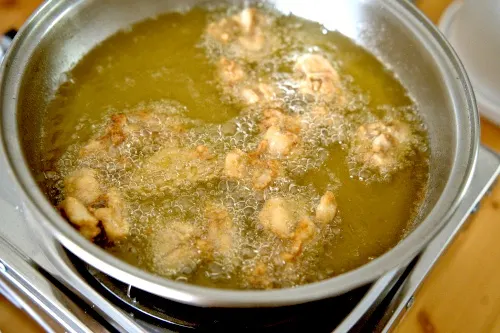
❺ Drain on a wire rack or paper towels
- Remove the chicken pieces with a slotted spoon once they turn golden brown.
- Drain the chicken pieces on a wire rack or a plate lined with paper towels.
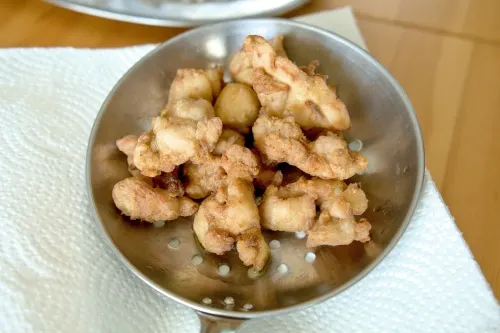
🍽️ How to serve chicken karaage
Japanese chicken karaage is best as a side dish or appetizer. It is perfect for lunch boxes or a summer picnic. It is usually served with lemon juice or mayonnaise. Kewpie mayo is the most common dipping sauce for karaage.
🗄️ Storage
Chicken karaage can be frozen and uncooked. Store the marinated chicken in a freezer bag or an airtight plastic container. When you want to deep-fry the karaage, defrost the chicken in the fridge and continue to deep fry.
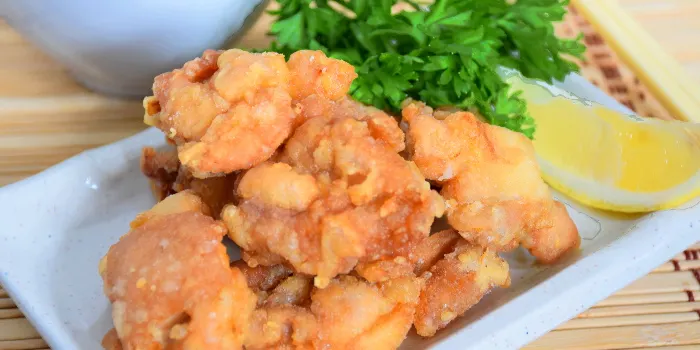
💡 Tips to make the best karaage
- Chicken thigh meat is normally used to make karaage as it is more flavorsome and juicier than breast meat. You can ask the butcher to debone the chicken to save time. Although chicken breasts can be used for this recipe, thighs have more flavor and are generally moister.
- Scoring the chicken thighs enables better absorption of the marinade and more even cooking.
- You can use ginger juice as a substitute for the chopped ginger.
- Add freshly ground black pepper and red chili flakes for a spicy version.
- Double dredging of flour makes the chicken extra crispy.
- Chicken thighs have a larger margin of tolerance to heat than chicken breasts, which are prone to dryness, so you can fry them a little longer until they’re extra golden brown and crispy. If you do not serve them immediately after deep-frying, you can fry the chicken a second time for a minute to regain crispiness.
- If you want to make the karaage crispier, try double frying. First, use medium heat, about 150 degrees Celsius, to deep-fry the karaage until light brown. Then, at a higher temperature of 190 degrees Celsius, deep-fry the chicken until golden brown, which will take another minute. It is best to use an instant-read thermometer to control the temperature. This method will yield very crispy chicken.
- To deep fry the chicken, use vegetable oil with a high smoke point. Peanut oil is my favorite, but you can also use other oils, such as corn oil or canola oil.
🔍 Which is the best coating for karaage- potato starch, cornstarch, or wheat flour?
Original Japanese karaage is deep-fried by coating the chicken with potato starch or a mix of potato and wheat flour. The potato starch creates a lasting layer of crispy coating around the karaage, making it perfect for bento lunch even after it becomes cold.
Cornstarch is a good alternative to potato starch, where potato starch is hard to get. Cooks have developed various combinations of potato starch, corn flour, and wheat flour for karaage recipes. These flours are used by native Japanese, too, and all produce good results, albeit results may vary in texture and the degree of crispiness.
Note: This preparation is different from another crowd-pleaser Japanese food: tempura. Tempura is deep-fried with a wet batter, whereas karaage is deep-fried by coating it with a dried flour mix.
A simple test
The following is a simple taste test of three combinations for the coating of karaage- potato starch, cornstarch, and a mix of potato starch and wheat flour to find out which one I prefer. The appearance and color of all combinations are identical after deep-frying with the same pot of oil, temperature, and duration.
- Cornstarch alone has a denser and crunchy texture than wheat and cornstarch after cooling for 15 minutes.
- Karaage with potato flour and potato/wheat flour combination has a slight feeling of raw flour to bite, which I prefer as it is a nice feeling in the mouth.
- The coating of potato and corn flour without the wheat flour is denser, whereas the combination of potato starch has the lightest and crispy crust.
My choice: The potato starch/wheat flour combination is the best. I like the slightly floury feeling to bite and the light and crispy crust compared to corn flour alone. And that is why I use a combination of potato starch and wheat flour in my recipe. The difference is marginal. You can use any of the combinations to achieve the result mentioned above.
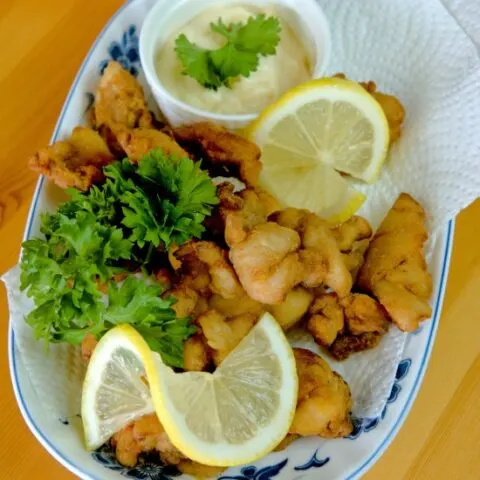
Chicken Karaage- Japanese fried chicken
This is an easy Japanese recipe that takes 15 minutes to cook.
Ingredients
- 500 g chicken thighs, skin-on, boneless, cut into 2.5 cm pieces
- 1 tablespoon ginger, , grated
- 1 clove garlic, , minced
- 4 teaspoons Japanese soy sauce
- 1 tablespoon sake
- 1 teaspoon sugar
- equal portion of wheat flour and potato starch for coating
- Lemon wedges to garnish
- Vegetable oil, for frying
Instructions
- Add the ginger, garlic, soy sauce, and sake in a bowl.
- Score the skinless side of the chicken in a crosshatch pattern. Be careful not to cut through the meat.
- Cut the chicken into bite-size pieces 2.5 cm in length, leaving the skin on it for extra crispiness.
- Marinate with ginger, garlic, soy sauce, and sake and refrigerate for at least 30 minutes and up to 8 hours.
- Drain off any excess liquid from the chicken. Then, dredge the chicken meat into the potato starch and wheat flour combination.
- Leave them aside, then dip them in the flour again.
- Pour at least a 1.5-inch layer of vegetable oil into a heavy-bottomed pot or wok and heat the oil to up 360 °F (180 °C).
- Deep fry the chicken until cooked and golden brown for about 5-7 minutes. Stir occasionally with chopsticks to avoid the chicken pieces sticking together.
- Drain the chicken pieces on a plate lined with a paper towel.
- Serve with lemon wedges.
Recommended Products
As an Amazon Associate and member of other affiliate programs, I earn from qualifying purchases.
Nutrition Information:
Yield: 2 Serving Size: 2 servingsAmount Per Serving: Calories: 891Total Fat: 42gSaturated Fat: 11gTrans Fat: 0gUnsaturated Fat: 31gCholesterol: 320mgSodium: 1025mgCarbohydrates: 62gFiber: 3gSugar: 5gProtein: 67g
The data was provided and calculated by Nutritionix on 6/1/2019

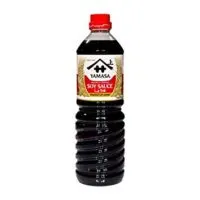
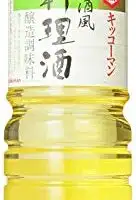
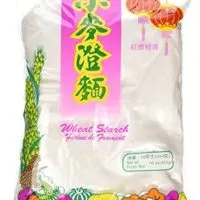
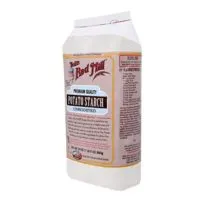
Easy pork chop recipe - How to make in 3 steps (Hainanese style)
Friday 21st of December 2018
[…] similar to the Hainanese pork chops, here are the links to the recipes that you might interested: Chicken karaage- Japanese fried chicken Chicken katsu recipe- How to make the best Japanese fried […]
nihari
Saturday 28th of October 2017
I love your recipes and your cooking way. I am a regular visitor of your site and this is my favorite recipe.
KP Kwan
Saturday 28th of October 2017
Hi Nihari, Thanks for dropping by our website and glad to know you like it. I just visited The Recipes Pakistan and thanks for introducing wonderful meal from where you stay.
KP Kwan
Maha Khan / sooperchef.pk
Thursday 27th of April 2017
you are great. I like your way of teaching us recipes method.I am new in recipes please Visit my website and tell me how I Improve my website https://www.sooperchef.pk
KP Kwan
Thursday 27th of April 2017
Hi Maha Khan, Your recipe looks great too, and I hope to see more delicious Pakistani recipes from you. KP Kwan
Rose
Tuesday 6th of December 2016
Thank you for this recipe, it is very good!
KP Kwan
Tuesday 6th of December 2016
Dear Rose,
Happy to know that it works. I like chicken karaage just as much as you do.
KP Kwan
How to prepare Scotch egg with oriental flavor ( 3 simple steps)
Tuesday 30th of August 2016
[…] is similar to those served with ramen. I deep fried the eggs until lightly golden brown, just like karaage and tempura. The eggs are served by nesting on a bed of carrot and daikon, and with kewpie […]